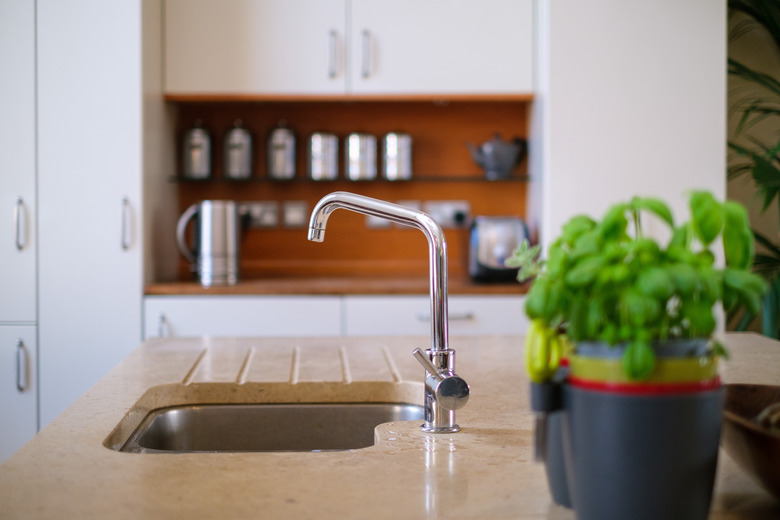How Reliable Is The Undermount Sink In A Laminate Countertop?
Undermount sinks install underneath the sink's countertop with special mounting brackets screwed into the counter itself. In granite or stone counters, the procedure is very stable and secure. However, in laminate counters with particle board cores, the stability is in question. Certain methods of mounting laminate sinks increase the reliability of the design.
Installing an Undermount Sink With Laminate Countertops
Installing an Undermount Sink With Laminate Countertops
Undermount sinks install on laminate counter tops differently than on granite or stone. The sink installs flush to the laminate, not below the surface of the counter to prevent water from soaking into the particleboard. This means an entirely different mounting procedure is necessary for an undermount sink with laminate countertops.
The counter is cut to accommodate the sink and the sink set inside with the rim flush to the laminate. Adhesive is injected between the sides of the sink and counter. Then the laminate is cut away, routed and sanded for a consistent transition and a seamless undermount sink.
Reliability of Sink Adhesives
Reliability of Sink Adhesives
The reliability of the undermount depends on the strength of the glues and adhesives because they hold the sink in place. Today, the products use advanced, strong adhesive chemicals to form a virtually unbreakable bond.
The adhesives maintain a bond even when exposed to the weight of the sink when it is filled with water. This presents the largest possible downward force exerted on the bond. As long as the adhesive is engineered to handle this type of force, the sink installation is reliable. Therefore, be sure to purchase adhesives made specifically for undermount sinks.
Types of Sinks Used as Undermounts
Types of Sinks Used as Undermounts
The type of sink used in the undermount installation affects its reliability because different sink materials have different properties and weights. According to This Old House, only stainless steel, quartz, and acrylic undermount sinks undermount on laminate counters, because the adhesives are made specifically to bond these materials.
Stainless steel and acrylic sinks are lighter than stone or ceramic sinks. This means less weight is constantly pulling down on the sink. That impacts the reliability of your installation. More weight pulling on the sink over a longer period of time increases the likelihood of a break or crack forming.
If you want to change the material of the sink itself during a remodel or renovation, you'll need to plan to replace laminate countertops with a material like granite for reliable undermount installation.
Potential Undermount Problems
Potential Undermount Problems
The main problem with an undermount sink in laminate is strength. Since the rim of the sink sits flush with the bottom of the laminate, the strength of the laminate is also an issue. If the laminate is weak, it will crack or bend if the sink's bond with the particle board is ever broken.
If additional weight is placed in the sink or the particle board becomes saturated with water, the bond may weaken and the sink might sag. When the sink sags, it pulls down on the edge of the counter along the installation area causing damage to the countertop. Proper maintenance of plumbing fixtures around the sink prevent this from happening.
